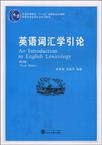英语词汇学引论
出版时间:1970-1 出版社:武汉大学出版社 作者:林承璋,刘世平 著 页数:452
Tag标签:无
前言
英语词汇学是研究英语语言词汇的一门重要学科。当前,高等学校的本科生、研究生,在比较熟悉英语语音、语法的情况下,学习和研究英语词汇就显得更加重要,更加迫切。 《英语词汇学引论》,是高等学校英语专业教材;是大学英语课(即公共英语课)教师和非英语专业的本科生、研究生,英语自学者及翻译工作者学习英语词汇学理论,理解、运用、掌握英语词汇,扩大英语词汇量,提高英语语言实践能力的参考书。 本书共八章。以现代语言学理论作为指导,以英语词汇为研究对象,着重论述英语词汇的来源、发展、现状及其研究方法;分析英语词的结构、类型、意义、理据、相互关系、语义的变化方式、过程及用法;研究英国英语和美国英语的差异;还对英语习语的特点、分类、语义以及英语词典的发展和使用都作了较详尽的阐述,并提供了大量的例证。 本书承北京外国语学院、北京第二外国语学院、北京师范大学、北京外交学院、复旦大学、上海外国语学院、上海师范大学、洛阳外国语学院、大连外国语学院、南京大学、四川大学和武汉大学12所院校,16位专家、教授参加审稿,并提出宝贵的意见和建议。北京外国语学院刘世沐教授代表高等学校外语专业教材编审委员会主持并指导了审稿工作。北京师范大学张韵斐教授和北京第二外国语学院周锡卿教授担任主审。武汉大学英文系主任潘耀琼教授,在整个编写过程中,给予热情的指导和帮助。武汉大学许海兰教授和美国专家PeterRoss对本书的语言文字进行了润饰和加工。编著者在此一并表示衷心感谢。 限于编者水平,书中谬误定属不少,敬请广大读者指正,不胜感谢。
内容概要
《英语词汇学引论(第4版)》是高等学校英语专业教材;是大学英语课课教师和非英语专业的本科生、研究生、英语自学者等学习英语词汇学理论,理解、运用、掌握英语词汇,扩大英语词汇量,提高英语语言实践能力的参考书。 《英语词汇学引论(第4版)》语词汇为研究对象,着重论述英语词汇的来源、发展、现状及其研究方 法;分析英语词的结构、类型、意义、理据、相互关系、语义的变化方式、过程及用法;研究英语和美国英语的差异;还对英语习语的特点、分类、语义以及英语词内的发展和使用都作了较详尽的阐述,并提供了大量的例证。
书籍目录
Chapter 1 Language,Linguistics and Lexicology1-1-1 Introductory Remarks1-1-2 A Definition of Language1-1-3 Language,Society and Thought1-2-1 A Definition of Li.nguistics1-2-2 The Scope of Linguistics1-3-1 What Is Lexicology?1-3-2 Aims and Significance of the Course of English Lexicology1-3-3 The Connection of Lexicology with Other Branches of Linguistics1-3-4 Two Approaches to the Study of English LexicologyChapter 2 The Sources of the English Vocabulary2-1-1 What is Etymology?2-1-2 The English People and the English Language2-1-3 The Position and Character of the English Language in the Indo-European Family2-1-4 The Divisions of the History Of the English Language2-1-5 Some Characteristics of Old English2-1-6 Some Characteristics of Middle English2-1-7 Some Characteristics of Modern English2-1-8 Etymological Twins in English2-1-9 Some Combining Forms Used in Modem English2-2-1 Words of Native Origin2-2-2 Borrowed Words in the English Vocabulary2-3-1 The Foreign Elements in the English Vocabulary2-3-2 The Scandinavian Element in the English Vocabulary2-3-3 The French Element in the English Vocabulary2-3-4 The Latin Element in the English Vocabulary2-3-5 The Greek Element in the English Vocabulary2-3-6 The Influence of the Classical Elements upon the English Vocabulary2-3-7 Other Foreign Elements in the English Vocabulary2-3-8 The Interrelation Between the Native and Foreign Elements in the English Vocabulary2-3-9 The Linguistic and Historical Origins of Some Common English WordsChapter 3 Word Meaning and Semantic Relations3-1-1 Some General Remarks on Semantics and Meaning3-1-2 The Relationship Between Meaning and the Object3-2-1 What Is a Word?3-2-2 Meaning and Motivation3-3-1 Classifications of Words3-3-2 Main Types of Word Meaning3-3-3 Word Meaning and Context3-4-1 Synonyms3-4-2 Antonyms3-4-3 Polysemy and Homonymy3-4-4 HyponymyChapter 4 The Changing English Vocabulary4-1-1 The Constant Change in Language and the Continuous Appearance of Neologisms4-1-2 The Definition of Neologisms or New Words4-1-3 The Rate of Changes of the English Vocabulary4-1-4 The Sources of New Words4-1-5 The Formation of Neologisms4-2-1 Archaisms4-3-1 Changes in Meaning4-3-2 Four Tendencies in Semantic Changes4-3-3 Semantic Changes from the Literal Use of Words to Their Figurative UseChapter 5 Word-formation in English5-1-1 Introduction5-1-2 Morphological Structure of Words5-1-3 Two Types of Morphemes5-1-4 Three Types of Words5-1-5 Root,Base,Stem5-2-1 The Main Processes of English Word-formation5-2-2 The Minor Processes of English Word-formationChapter 6 English Idioms6-1-1 Introduction6-1-2 The Definition of Idioms6-1-3 The Significance of Studying English Idioms6-1-4 The Features of English Idioms6-1-5 English Idioms in Different Styles6-1-6 The Difference Between Idiomatic and Free Phrases6-2-1 Classifications of English Idioms6-2-2 Some Useful Language Areas of IdiomsChapter 7 English Collocations7-1-1 Introduction7-1-2 What Is a Collocation?7-1-3 The Importance of Learning English Collocations7-2-1 The Classification of English Collocations7-2-2 Register Used in English Collocations7-3-1 Some Commonest Words Used in English Collocations.7-4-1 Different Subjects of English Collocations7-4-2 Families7-4-3 Houses,Flats and Rooms7-4-4 Food and Drink7-4-5 Study and Learning7-4-6 Fitness and Illness7-4-7 Job and Work7-4-8 Computers7-4-9 Sport7-4-10 TimeChapter 8 British and American English8-1-1 English as a Language of Worldwide Use8-1-2 British and American English8-1-3 The Historical Background of American English8-2-1 Differences between British English and American English8-2-2 Differences in Individual Sounds8-2-3 Differences in Stress8-2-4 Differences in Spelling8-2-5 Differences in Vocabulary8-2-6 Differences in Grammar8-3-1 A Comparison Between Websters Pronunciation Symbols (WPS) and International Phonetic Alphabet (IPA)8-3-2 British and American English in the FutureChapter 9 English Dictionaries and How to Use Them9-1-1 What Is a Dictionary?9-1-2 Characteristics of Dictionaries9-2-1 Types of Dictionaries9-2-2 Monolingual,Bilingual and Mulfilingual Dictionaries9-2-3 General and Special Dictionaries9-2-4 Pocket,Medium-sized and Unabridged Dictionaries9-2-5 Synchronic and Diachronic Dictionaries9-2-6 Encyclopedias and Encyclopedic Dictionaries9-2-7 The Printed and Electronic Dictionaries9-3-1 The History of English Dictionaries9-3-2 A Brief Introduction of Five Newest English Dictionaries9-3-3 Five Periods in the History of English Dictionaries9-4-1 How to Use English DictionariesAppendix 1An English-Chinese List of Technical Terms of Lexicology Used in This BookAppendix 2The Review of a Newest BookBibliography
章节摘录
2-1-8 Etymological Twins in English In the course of the development of the English vocabulary we may findthat there are a few pairs of words which came from the same languagesource. At the beginning of the formation of words they were similar notonly in form but also in meaning. As time went by their senses becamedivergent, especiaUy today. AcCording to the linguistic phenomenon we callthese pairs of words etymological twins or etymological variants in English. Let us take six pairs of words for example. human and humane: The word human used as an adjective in the 14th century was derivedfrom the Middle French word humain, also from the Latin word h~m~nus.The meaning is of or belonging to man, and the stress is on the firstsyllable. Now it has two meanings: one is of or characteristic of man; theother is having or showing the better qualities of man; kind; good. The word humane was also used as an adjective in the 15th century. Atthat time~ the word meant of or belonging to man. Later, in the 18thcentury, the word meant kind, merciful.The stress is on the secondsyllable. Now it has two meanings: one is having or showing sympathy,kindness and understanding, the other is (of areas of learning) tending tocivilize. urban and urbane: The word urban used as an adjective came from the Latin word urbanusin 1619. The meaning is of or pertaining to a city or city life, and the This part is chiefly based on Chambers Dictionary of Etymology. New York:Chambers Harrap Publishers Ltd., 20011 and Websters Word Histories. Springfield,MA: Merriam-Webster. The present meanings of the examples given are quoted from Oxford AdvancedLearners English-Chinese Dictionary( Extended Fourth Edition). Beijings The Commercial Press and Oxford University Press, 2002.
编辑推荐
采用历时和共时分析的研究方法,讲述了许多英语词汇的有趣故事,论述了词义的历时演变和同源词的比较,并对大量例词指出了产生的年代。 对英语新词语的定义、时间划分标准、大小分类及其出现的年代都作了明确的界定,并用简单的英语解释新词的含义。 英语构词法分类独特,例证丰富,配上大量新词.对扩大英语词汇量起到了指导作用。 增加了英语常用习语15种表达法,其中还有未曾学过的新习语,并注明其含义。 增加了英语词语搭配一章。对词语搭配的定义、重要性及其分类作了详尽的阐述,并通过大量实例进行剖析,在必要的地方还配了中文解释,起到了一部小型英语词语搭配词典的作用。 阐述了词典的新定义。增加了21世纪初(2001年到2006年间)5部英美国家出版的英语学习词典的评介。 附录2介绍了著名词汇学家、语言学家Pa…ckHanks主编的《词汇学:语言学中的关键概念》一书于2006年在英国出版的最新信息:它是一部迄今为止最全面的词汇学巨著,全书共6卷,2768页,值得推荐。 《英语词汇学引论(第4版)》内容新颖,材料翔实,反映了21世纪初英语语言词汇的新发展。 《英语词汇学引论(第4版)》语言通俗易懂,理论联系实际,融趣味性、科学性、思想性为一体,是一本英语专业学生、英语自学者、研究生可读性强的教材和英语教师的教学参考书。
图书封面
图书标签Tags
无
评论、评分、阅读与下载
用户评论 (总计1条)
- 好评。英语词汇学引论。正版书。
